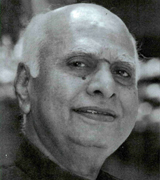Main Feature
C.R. Vyas

Essayist Joseph Addison wrote: "Music is the only sensual gratification which mankind may indulge in without injury to its morals or religion." For Chintaman Raghunath Vyas, the veteran singer who passed away on 10 January this year, music was a life-long indulgence.
C.R. Vyas belonged to that generation of musicians who had witnessed the peak of glory which Hindustani music had attained during the first six decades of the 20th century. Not only did he get a ringside view of the great happenings, he was a participant too.
C.R. Vyas was born on 9 November 1924 in a Maharashtrian brahmin family in Osmanabad which was then under the rule of the Nizam of Hyderabad. Even though the family did not have a musical lineage, he showed an aptitude for learning the art. Initially, he received basic instruction from Govindrao Bhatambrekar, an exponent of the Kirana gharana. Later, when he shifted to Bombay to earn a livelihood for himself and his family, he approached Rajarambuwa Paradkar. A saintly singer who was an offspring of a branch of the Gwalior gharana, Paradkar had links also with the keertana tradition which had a close bond with the classical music tradition in Maharashtra. Vyas learnt from him in the traditional gurukula system for almost 15 years.
On Hindustani Music
The Raga-ness Of Raga-s - II
The dimensions of raga-ness fall into two categories: melodic grammar and aesthetic grammar. Melodic grammar refers to the selection, sequencing, and relative importance of swara-s in a raga, while aesthetic grammar refers to aspects of shaping the distinctive aural experience of the raga in performance. A raga can remain identifiable even by adherence to the melodic grammar, and therefore enjoys mandatory status. Aesthetic grammar is, comparatively, more susceptible to different interpretations, and levels of compliance, and to change over a period of time. To this extent, aesthetic grammar lies on the borderline between grammar and literature.
Melodic grammar of raga-s
Melodic grammar begins with the permissible swara-s of a raga. The vast majority of raga-s utilise a minimum of five swara-s. The few raga-s which use four swara-s are performed only rarely—obviously due to their limited melodic potential. On this basis, raga-s are classified into chatuswara (quadratonic), audava (pentatonic), shadava (hexatonic) and sampoorna (heptatonic). Raga-s which use a different number of swara-s in the ascent and the descent are described either as audavasampoorna or a shadavasampooma.


